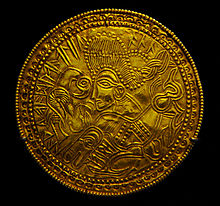Runic sequence ALU
The runic sequence ALU (ᚨᛚᚢ) can be found on Iron Age inscriptions (especially between the 3rd and 8th centuries) in the older Futhark in Scandinavia and less often in England .
The inscription consists of the runes Ansuz, Laguz and Urus. The word appears either alone (as on the rune stone N KJ57 from Elgesem in Norway ) or as part of a formula (as on the amulet from Lindholmen (DR 261) in Skåne in Sweden ). The origin and meaning of the word are debatable, although there is agreement among scholars that the word is runic magic, or a metaphor for it. It is the most common beginning of runic curses.
The word disappears even before Scandinavia was Christianized . Beyond this period, it can increasingly be associated with the sequence ale in Old Norse poetry.
The inscription appears among other things
- DR BR42 (pictured)
- the bracteates : G 205, DR BR6, DR BR13, DR BR25, DR BR54, DR BR59, DR BR63A, DR BR67, DR EM85; 123, and DR NOR2002; 10
- the rune stones : N KJ57 from Elgesem, N KJ58 from Årstad; Stone from Eggja (also Eggjum No. N KJ101) and on fragments such as that of Kinneve and the slate (oil ACTARC37; 211) from Gräsgård near Eketorp Castle on Öland
literature
- Wilhelm Heizmann : The formula words of the gold bracteates. In: Wilhelm Heizmann, Morten Axboe (Hrsg.): The gold bracteates of the migration period - evaluation and new finds (= Reallexikon der Germanischen Altertumskunde - supplementary volumes, volume 40). Walter de Gruyter, Berlin / New York 2011, pp. 525–601; here 533 ff.


